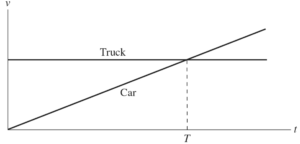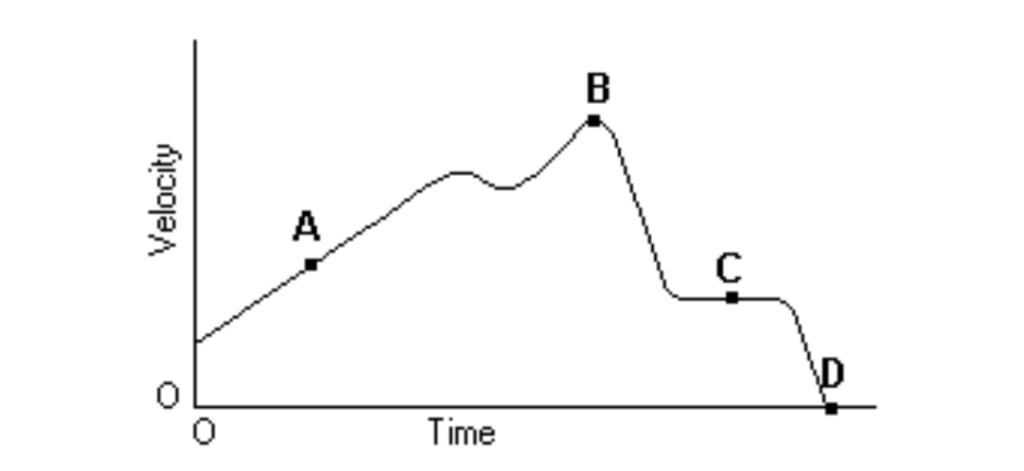Part a:
| Step | Derivation/Formula | Reasoning |
|---|---|---|
| 1 | y = y_0 + v_0 t – \frac{1}{2} g t^2 | This is the kinematic equation for vertical position, where y_0 is the initial position, v_0 is the initial velocity, g is the acceleration due to gravity, and t is the time. |
| 2 | Substitute y = 0, y_0 = 800\ \text{m}, v_0 = 65\ \text{m/s}, g = 9.8\ \text{m/s}^2 | The object hits the ground when y=0. It is thrown upward from a height of 800 m and the initial velocity is upward, hence positive. |
| 3 | 0 = 800 + 65t – 4.9t^2 | Rearrange the substituted equation and simplify g/2 from 9.8/2 to 4.9. |
| 4 | 4.9t^2 – 65t – 800 = 0 | This is a quadratic equation in the form of at^2 + bt + c = 0. |
| 5 | t = \frac{-b \pm \sqrt{b^2 – 4ac}}{2a} | Apply the quadratic formula to solve for t. Here, a = 4.9, b = -65, and c = -800. |
| 6 | t = \frac{-(-65) \pm \sqrt{(-65)^2 – 4 \cdot 4.9 \cdot (-800)}}{2 \cdot 4.9} | Plug in the values of a, b, and c. |
| 10 | t \approx 21.03\ \text{s} \textbf{ (positive root)} | Discard negative time and keep the physically meaningful positive root, being the actual time the object takes to hit the ground. |
Part b:
| Step | Derivation/Formula | Reasoning |
|---|---|---|
| 1 | v = v_0 – gt | Use the kinematic equation for velocity in vertical motion, taking downward as the negative direction. |
| 2 | v = 65 – 9.8 \times 21.04 | Substitute the values of g and t into the equation. |
| 3 | v \approx -141.14\ \text{m/s} | Subtract to find the final velocity, where negative indicates direction downwards. |
Part c:
| Step | Derivation/Formula | Reasoning |
|---|---|---|
| 1 | v \propto v_0 | The final velocity is proportional to the initial velocity when all other factors remain the same. |
| 2 | v_{\text{final, new}} = 2v_0 – gt | Note this is the equation we used in part b to find the final speed. Time, however, is not the same in the two scenarios. So unless you have found time with the double the initial speed, do NOT use this equation again. |
| 3 | v_{\text{final, new}} = {2v_0}^2 + 2g\Delta \theta | Use this kinematic equation instead. |
| 4 | {v_{\text{final, new}}}^2 = = 180.54 \, m/s | Plug in values and solve for the new final speed. |
| 5 | \frac{v_{\text{final, new}}}{v_{\text{final, orginal}} | Find the factor the final velocity has increased by. |
| 6 | \frac{180.54}{141.14} \approx 1.28 | Plug in values and solve. |
| 7 | Factor = 1.28 | If the initial velocity doubles the final velocity of the ball increases by a factor of 1.28. |
Phy can also check your working. Just snap a picture!
An object is dropped from the top of a 45 m tall building
A car is traveling 20 m/s when the driver sees a child standing on the road. She takes 0.8 s to react then steps on the brakes and slows at 7.0 m/s2. How far does the car go before it stops?

The motions of a car and a truck along a straight road are represented by the velocity-time graphs in the figure. The two vehicles are initially alongside each other at time t = 0. At time T, what is true of the distances traveled by the vehicles since time t = 0?
There are two cables that lift an elevator, each with a force of 10,000 N. The 1,000 kg elevator is lifted from the first floor and accelerates over 10 m until it reaches its top speed of 6 m/s. What is the mass of the people in the elevator?
 Above is the graph of the velocity vs. time of a duck flying due south for the winter. At what point might the duck begin reversing directions?
Above is the graph of the velocity vs. time of a duck flying due south for the winter. At what point might the duck begin reversing directions?
By continuing you (1) agree to our Terms of Sale and Terms of Use and (2) consent to sharing your IP and browser information used by this site’s security protocols as outlined in our Privacy Policy.
| Kinematics | Forces |
|---|---|
| \Delta x = v_i t + \frac{1}{2} at^2 | F = ma |
| v = v_i + at | F_g = \frac{G m_1m_2}{r^2} |
| a = \frac{\Delta v}{\Delta t} | f = \mu N |
| R = \frac{v_i^2 \sin(2\theta)}{g} |
| Circular Motion | Energy |
|---|---|
| F_c = \frac{mv^2}{r} | KE = \frac{1}{2} mv^2 |
| a_c = \frac{v^2}{r} | PE = mgh |
| KE_i + PE_i = KE_f + PE_f |
| Momentum | Torque and Rotations |
|---|---|
| p = m v | \tau = r \cdot F \cdot \sin(\theta) |
| J = \Delta p | I = \sum mr^2 |
| p_i = p_f | L = I \cdot \omega |
| Simple Harmonic Motion |
|---|
| F = -k x |
| T = 2\pi \sqrt{\frac{l}{g}} |
| T = 2\pi \sqrt{\frac{m}{k}} |
| Constant | Description |
|---|---|
| g | Acceleration due to gravity, typically 9.8 , \text{m/s}^2 on Earth’s surface |
| G | Universal Gravitational Constant, 6.674 \times 10^{-11} , \text{N} \cdot \text{m}^2/\text{kg}^2 |
| \mu_k and \mu_s | Coefficients of kinetic (\mu_k) and static (\mu_s) friction, dimensionless. Static friction (\mu_s) is usually greater than kinetic friction (\mu_k) as it resists the start of motion. |
| k | Spring constant, in \text{N/m} |
| M_E = 5.972 \times 10^{24} , \text{kg} | Mass of the Earth |
| M_M = 7.348 \times 10^{22} , \text{kg} | Mass of the Moon |
| M_M = 1.989 \times 10^{30} , \text{kg} | Mass of the Sun |
| Variable | SI Unit |
|---|---|
| s (Displacement) | \text{meters (m)} |
| v (Velocity) | \text{meters per second (m/s)} |
| a (Acceleration) | \text{meters per second squared (m/s}^2\text{)} |
| t (Time) | \text{seconds (s)} |
| m (Mass) | \text{kilograms (kg)} |
| Variable | Derived SI Unit |
|---|---|
| F (Force) | \text{newtons (N)} |
| E, PE, KE (Energy, Potential Energy, Kinetic Energy) | \text{joules (J)} |
| P (Power) | \text{watts (W)} |
| p (Momentum) | \text{kilogram meters per second (kgm/s)} |
| \omega (Angular Velocity) | \text{radians per second (rad/s)} |
| \tau (Torque) | \text{newton meters (Nm)} |
| I (Moment of Inertia) | \text{kilogram meter squared (kgm}^2\text{)} |
| f (Frequency) | \text{hertz (Hz)} |
General Metric Conversion Chart
Example of using unit analysis: Convert 5 kilometers to millimeters.
Start with the given measurement: \text{5 km}
Use the conversion factors for kilometers to meters and meters to millimeters: \text{5 km} \times \frac{10^3 \, \text{m}}{1 \, \text{km}} \times \frac{10^3 \, \text{mm}}{1 \, \text{m}}
Perform the multiplication: \text{5 km} \times \frac{10^3 \, \text{m}}{1 \, \text{km}} \times \frac{10^3 \, \text{mm}}{1 \, \text{m}} = 5 \times 10^3 \times 10^3 \, \text{mm}
Simplify to get the final answer: \boxed{5 \times 10^6 \, \text{mm}}
Prefix | Symbol | Power of Ten | Equivalent |
|---|---|---|---|
Pico- | p | 10^{-12} | 0.000000000001 |
Nano- | n | 10^{-9} | 0.000000001 |
Micro- | µ | 10^{-6} | 0.000001 |
Milli- | m | 10^{-3} | 0.001 |
Centi- | c | 10^{-2} | 0.01 |
Deci- | d | 10^{-1} | 0.1 |
(Base unit) | – | 10^{0} | 1 |
Deca- or Deka- | da | 10^{1} | 10 |
Hecto- | h | 10^{2} | 100 |
Kilo- | k | 10^{3} | 1,000 |
Mega- | M | 10^{6} | 1,000,000 |
Giga- | G | 10^{9} | 1,000,000,000 |
Tera- | T | 10^{12} | 1,000,000,000,000 |
The most advanced version of Phy. Currently 50% off, for early supporters.
per month
Billed Monthly. Cancel Anytime.
Trial –> Phy Pro
A quick explanation
UBQ credits are specifically used to grade your FRQs and GQs.
You can still view questions and see answers without credits.
Submitting an answer counts as 1 attempt.
Seeing answer or explanation counts as a failed attempt.
Lastly, check your average score, across every attempt, in the top left.
MCQs are 1 point each. GQs are 1 point. FRQs will state points for each part.
Phy can give partial credit for GQs & FRQs.
Phy sees everything.
It customizes responses, explanations, and feedback based on what you struggle with. Try your best on every question!
Understand you mistakes quicker.

For GQs and FRQs, Phy provides brief feedback as to how you can improve your answer.
Aim to increase your understadning and average score with every attempt!
10 Free Credits To Get You Started
*Phy Pro members get unlimited credits

By continuing you agree to nerd-notes.com Terms of Service, Privacy Policy, and our usage of user data.